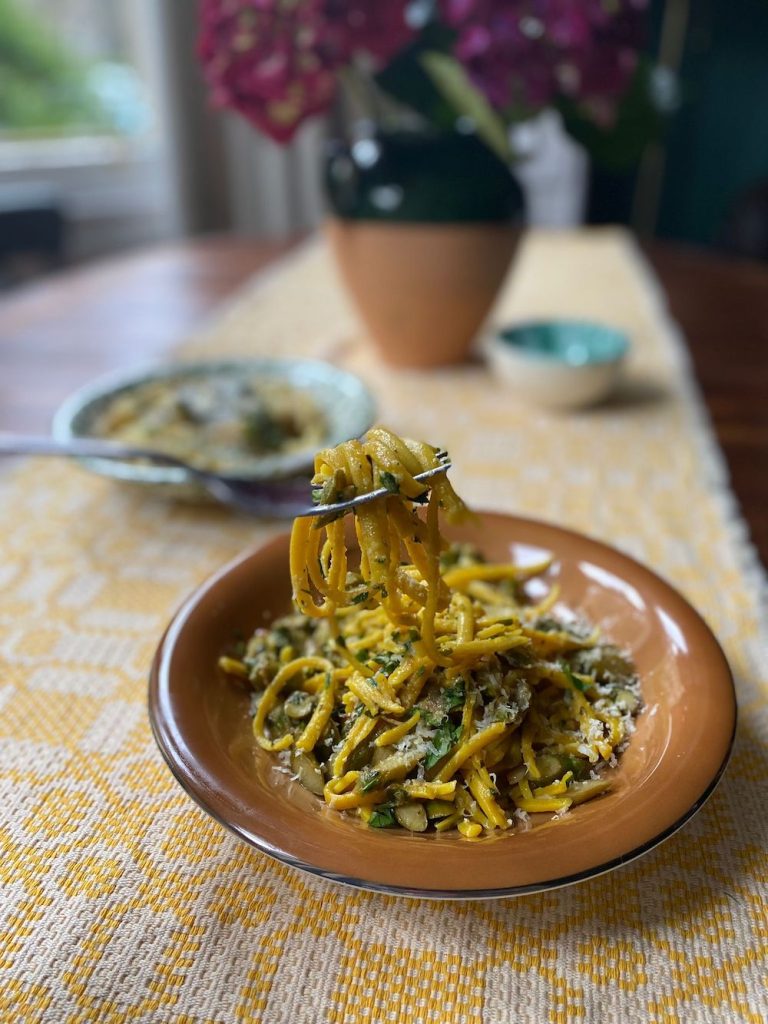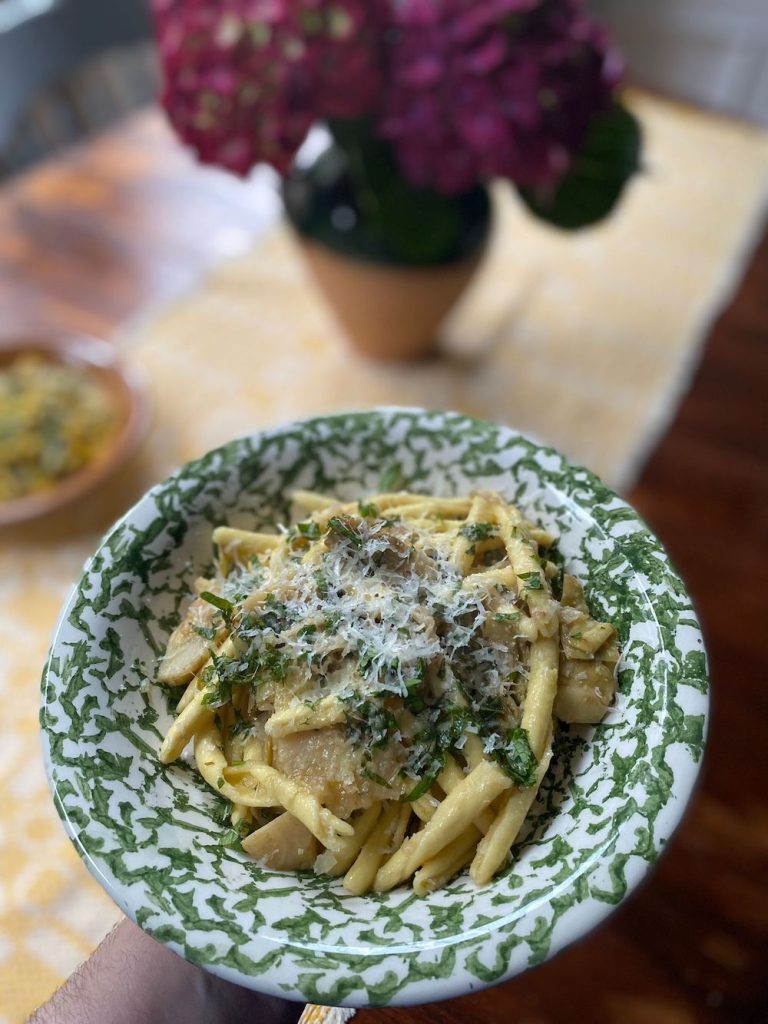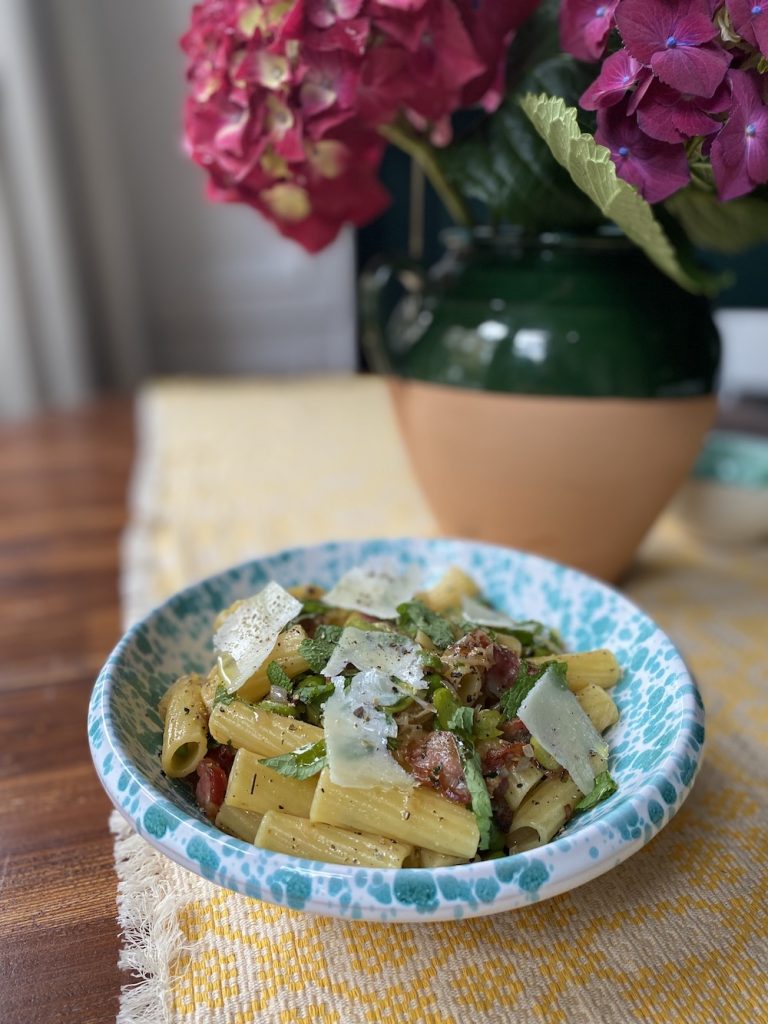3 Pasta Dishes that Celebrate the Flavours of Spring
Springtime in Italy (primavera); the season of new life and new beginnings. Flowers welcome the season, beginning with mimosa for La Festa della Donna (International Women’s Day) in March, followed by the eruption of cherry blossoms and wisteria in April, and ending with the wild poppies blooming in May. The warmer weather and fewer tourists make it an ideal time to visit. Even in an April thunderstorm the dark skies contrast beautifully against the dramatic architecture across the country. And, of course, when I think of primavera in Italy, I think of the food – extravagant Easter feasts, the first gelato of the season, and market stalls overflowing with an abundance of green vegetables and fresh flavours – artichokes, asparagus, broad beans, courgette, peas, and mint.

Primavera Flavours
For the month of May, I wanted to write about three pasta dishes that celebrate these typical primavera flavours. All of these dishes are quick and easy to make, and – like most authentic Italian recipes – use few ingredients, but ingredients that are seasonal and of the best quality. They embody Antonio Carluccio’s motto; minimum of fuss, maximum of flavour.
Even if you are not visiting Italy this springtime, I hope these recipes transport you there and offer a taste of la primavera.
Asparagus and lemon
Agli asparagi e limone

This dish is the epitome of seasonal springtime flavours and colours; it is fresh and vibrant, and the zestiness of the lemon really enhances the flavour of the asparagus.
Ingredients (serves 2):
Pasta – I would recommend using linguine or spaghetti for this dish;
Extra virgin olive oil;
A small bunch of asparagus, cut diagonally;
2 cloves of garlic, finely chopped;
A pinch of chilli flakes;
Juice and zest of 1 lemon;
A small glass of white wine;
A small bunch of parsley, finely chopped;
Parmigiano Reggiano cheese
Method:
- Bring a large pan of salted water to the boil and add the pasta.
- Add a drizzle of extra virgin olive oil to a pan on medium-high heat. Then add the asparagus and a pinch of salt.
- Sauté the asparagus for a few minutes, then add the garlic and chilli flakes and sauté for a further minute.
- Add the lemon juice and zest, mix well, then add the wine.
- Drain the pasta, reserving some of the pasta water.
- When the wine has evaporated, add the parsley, and some of the pasta water to create a sauce.
- Add pasta into the sauce and toss to combine.
- Serve with grated Parmigiano Reggiano and a drizzle of extra virgin olive oil. Buon appetito!
Artichoke and mint
Ai carciofi e menta

The best artichokes I have ever eaten were carciofi alla giudìa in the Jewish Quarter of Rome (il Ghetto di Roma); deep fried artichokes with salt. The artichokes surprisingly do not absorb a lot of oil and the leaves form crispy petals. They are so simple, but so delicious.
However, for springtime, I prefer the fresher flavours of carciofi alla Romana – a traditional Roman dish of artichokes stuffed with mint and garlic, braised until tender. I have based this pasta recipe on the primavera flavours of carciofi alla Romana.
Ingredients (serves 2):
Pasta – I would recommend using a short pasta such as penne, casarecce or maccheroni for this dish;
Extra virgin olive oil;
1 shallot (cut the shallot in half lengthways and then finely slice into half-moon shapes);
2 cloves of garlic, finely chopped;
Artichokes (you can either use fresh artichokes – around one per person – or around 150g artichoke hearts jarred in olive oil), roughly sliced;
Half a lemon (if using fresh artichokes);
A small glass of white wine;
A handful of mint, finely chopped;
Pecorino cheese
Method:
If you are using fresh artichokes, begin by preparing those:
- Remove the tough outer leaves from the artichokes until you get to the thinner, yellow leaves.
- Use a paring knife to trim the top of the artichoke so that the inside is exposed. You can either remove the stem completely or use the paring knife or a peeler to trim it.
- Cut the artichokes in half lengthways and remove the choke (the fuzzy, hair-like material).
- Rub the artichokes and stem with lemon to prevent them from discolouring (and to prevent your hands from getting dirty).
- You should now be left with the artichoke heart, which is the most tender part of the artichoke. If there are any tough parts on the heart, you can remove those using the paring knife.
- Roughly slice the artichoke hearts and place them in a bowl of water. Squeeze in the lemon juice from the lemon you used earlier – again, this will ensure that the artichokes stay fresh and do not discolour while you wait to cook them.
To make the pasta:
- Bring a large pan of salted water to the boil and add the pasta.
- Add a drizzle of extra virgin olive oil to a pan on medium-high heat, then add the shallot and sauté until translucent. Add the garlic and a pinch of salt and sauté for a further minute.
- Add the artichokes and the wine. Once the wine has evaporated, add a splash of water if required and simmer until the artichokes are tender.
- Drain the pasta and add to the sauce with some of the pasta water.
- Top the pasta with mint, Pecorino and a good drizzle of extra virgin olive oil. Buon appetito!
Broad bean, guanciale and pecorino
Le fave, guanciale e pecorino

This dish is based on one of the four Holy-grail pastas of Rome, pasta alla Gricia, with the addition of broad beans.
Ingredients (serves 2):
Pasta – I would recommend using a short pasta such as rigatoni or penne for this dish;
100 to 150g guanciale (cured pork jowl), thinly sliced;
1 shallot, finely chopped;
150g podded broad beans;
A small handful of mint;
Pecorino cheese;
Black pepper
Method:
- Bring a large pan of salted water to the boil and add the pasta.
- Add the guanciale to a wide based pan on a high heat. Fry until the fat has rendered and the guanciale is starting to become crispy, then reduce to a medium-high heat.
- Add the shallot to the pan and sauté until it becomes translucent.
- Then, add the broad beans and half of the mint (finely chopped) to the pan and mix well. Add a splash of water to the pan to ensure the broad beans are tender.
- Drain the pasta and add to the pan, using some of the pasta water to emulsify a sauce.
- Top the pasta with pecorino, lots of black pepper, and the remaining mint leaves. Buon appetito!


I always enjoy Natalia’s posts, as I like the research she puts into the background behind the recipes, plus the food styling photos are lovely. My sister has lived in Italy for over 40 years and she enjoys them too – she is keen to try the mint and artichoke version.